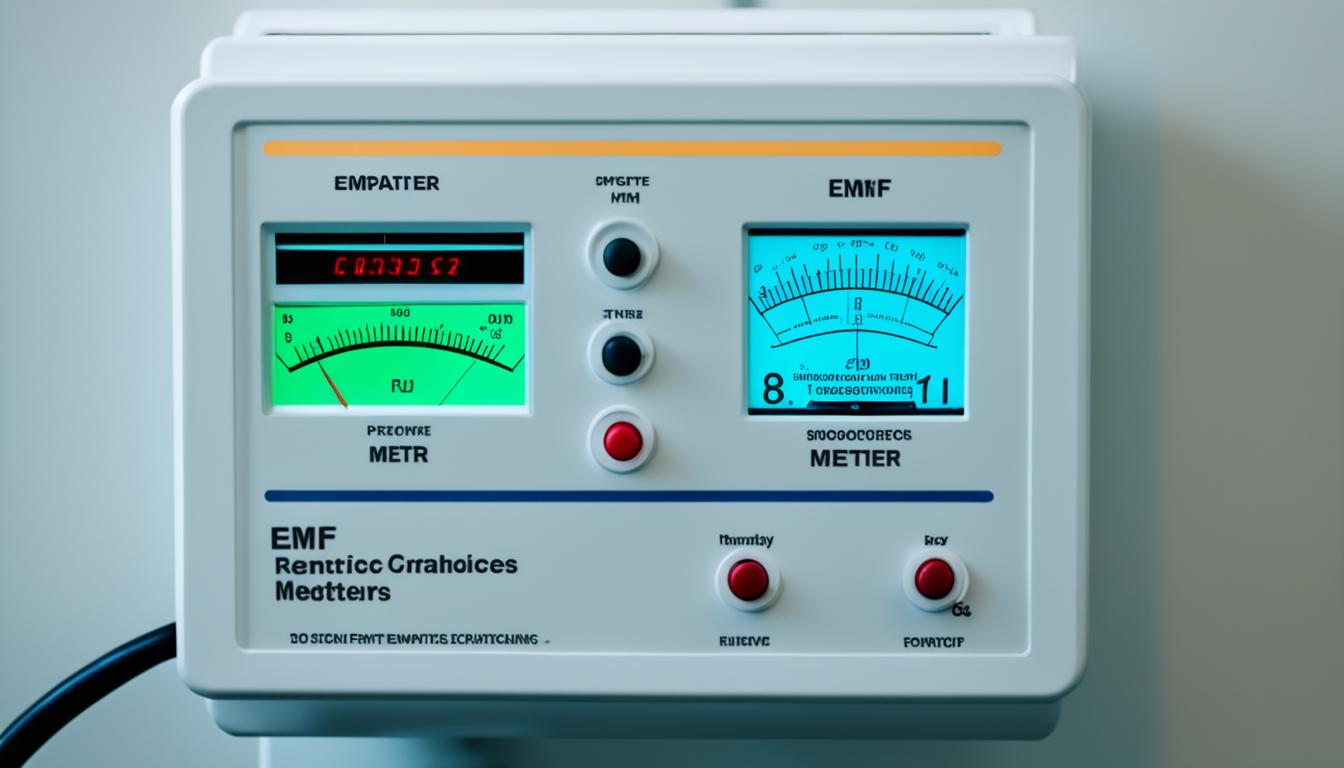Disclosure: This Post Contains Affiliate Links; We earn a commission on purchases.
Electric and magnetic fields (EMF) are fundamental forces of nature that exist wherever electricity is generated, transmitted, or used. They are a combination of electrical and magnetic fields, with the strength of the EMF depending on the amount of electricity in use (current) and the voltage in the electric circuit. EMFs can be measured in volts per meter (V/m) for electric fields and in tesla (T) or gauss (G) for magnetic fields.
The frequency of the electrical source also plays a role, ranging from direct current (DC) to millions of cycles per second (hertz, Hz). Concerns about EMF arise from the possible biological effects of exposure to external, artificially produced EMFs, although scientific evidence does not indicate any health effects from commonly encountered exposure levels.
Key Takeaways:
- EMF is a combination of electrical and magnetic fields present wherever electricity is used.
- The strength of the EMF depends on the current, voltage, and frequency of the electrical source.
- Scientific evidence does not indicate health effects from commonly encountered EMF exposure.
- EMF can be measured in volts per meter for electric fields and tesla or gauss for magnetic fields.
- Understanding EMF is crucial for making informed decisions and minimizing potential risks.
Characteristics of EMF
Understanding the characteristics of electromagnetic fields (EMF) is crucial in assessing potential health risks and adopting safety measures. EMF is a combination of electrical and magnetic fields that are generated wherever electricity is used. Electrical fields are measured in volts per meter (V/m), while magnetic fields are measured in tesla (T) or gauss (G). A higher current or voltage results in a greater EMF, and typical magnetic field measurements range from microtesla (µT) levels.
The frequency of the electrical source is another important factor to consider. In North America, the standard frequency is 60 Hz, while in Europe, it is 50 Hz. It is important to note that concerns about EMF health risks primarily stem from the role of internal electric fields and currents in physiological processes. However, scientific research has not yet found conclusive evidence of direct health effects from EMF exposure.
Despite the lack of conclusive findings, it is still recommended to limit continuous EMF exposure for the general public. Guidelines suggest maintaining electric field strengths below 5 kilovolts per meter (kV/m) and magnetic fields below 0.1 millitesla (mT).
EMF Exposure Guidelines
- Avoid prolonged exposure to EMF levels exceeding recommended field strengths.
- Keep a safe distance from high-voltage power lines, transformers, and other EMF-emitting sources.
- Use handheld electronic devices, such as cell phones and tablets, with caution, and consider using hands-free options to reduce direct EMF exposure.
- Minimize the use of wireless technology and opt for wired connections whenever possible.
- Consider using EMF shielding materials, such as conductive fabrics or paints, to reduce the penetration of EMF into living spaces.
- Limit screen time and promote a balanced use of electronic devices.
By understanding the characteristics of EMF and implementing safety measures, individuals can make informed decisions to mitigate potential risks associated with EMF exposure.
EMF and Health Concerns
Public concern about the possible health effects of EMF exposure has led to research and investigations by various organizations, including the Institute of Electrical and Electronics Engineers (IEEE), World Health Organization (WHO), Environmental Protection Agency (EPA), and Department of Energy (DOE). Studies have looked into the potential link between EMF exposure and cancer, particularly childhood leukemia, with mixed findings. Some studies suggest a weak association between magnetic field exposure and certain types of cancer, but overall, the evidence is inconclusive. Additional research is ongoing to further understand the effects of EMF on human health.
Despite the inconclusive evidence, it is understandable why the concern about EMF health risks exists. EMFs generated by various sources, such as power lines, electronic devices, and wireless technology, have become an integral part of modern life, raising questions about their potential impact on human health. The possible association between EMF exposure and cancer, especially childhood leukemia, has received significant attention.
“The evidence suggests a weak link between EMF exposure and certain types of cancer, but the overall scientific consensus is still inconclusive.”
The World Health Organization (WHO) has classified EMFs as possibly carcinogenic to humans, based on limited evidence of a potential connection with childhood leukemia. However, they also emphasize that these findings are not sufficient to establish a causal relationship. Other studies investigating the link between EMFs and different cancer types have yielded mixed and inconclusive results.
It is crucial to note that the levels of EMF exposure from everyday sources are typically well below the recommended safety limits set by organizations such as the IEEE and WHO. Nevertheless, ongoing research aims to expand our understanding of the potential health effects of EMFs and provide further clarity on this topic.

EMF Exposure and Health Risks
Table: EMF Exposure and Health Risks by Source
| EMF Source | Potential Health Risks |
|---|---|
| Power Lines | Possible increased risk of childhood leukemia (inconclusive) |
| Cell Phones | No conclusive evidence of increased cancer risk |
| Wi-Fi Routers | No conclusive evidence of increased cancer risk |
| Smart Meters | No conclusive evidence of increased cancer risk |
In summary, while some studies have suggested a weak association between EMF exposure and specific types of cancer, the overall scientific consensus is that the evidence is inconclusive. Ongoing research and investigations continue to shed light on the potential health effects of EMF, ultimately helping individuals make informed decisions regarding their exposure levels and potential protective measures.
EMF Protection Strategies
While the scientific evidence regarding the health effects of EMF is inconclusive, individuals who are concerned about their exposure can take steps to minimize their exposure to EMF.
One effective strategy is to invest in EMF shielding materials. These materials are designed to block or reduce the penetration of EMF into living spaces. Conductive fabrics or paints can be used to create a barrier against EMF radiation. By incorporating these materials into your home or workplace, you can create a safer environment.
Another important step is to maintain a distance from EMF-emitting sources. For example, try to keep a safe distance from power lines, electrical appliances, or wireless devices whenever possible. This can help reduce your overall EMF exposure.
Using wired connections instead of wireless technology is another effective strategy. Wired connections, such as Ethernet cables, can provide a more stable and secure connection without the need for wireless signals that emit EMF.
Limiting the use of electronic devices can also help in minimizing EMF exposure. Consider taking regular breaks from your gadgets and encouraging screen-free activities. By reducing your reliance on electronic devices, you can reduce your overall exposure to EMF.
Remember, everyone’s tolerance and sensitivity to EMF may differ, and reducing exposure is a personal choice. Implementing these EMF protection strategies can offer reassurance to those who are concerned about their EMF exposure.
EMF Protection Checklist:
- Use EMF shielding materials like conductive fabrics or paints.
- Maintain a safe distance from EMF-emitting sources.
- Opt for wired connections instead of wireless technology.
- Limit the use of electronic devices.
By following these strategies and being mindful of your exposure to EMF, you can take proactive steps towards protecting yourself and your loved ones.
Don’t let uncertainty about the health effects of EMF overshadow the positive aspects of technology. With these protection strategies, you can enjoy the benefits of modern living while minimizing potential risks.

EMF and Everyday Life
EMF is a part of everyday life due to the widespread use of electronic devices, power lines, and wireless technology. It is important to understand that the strength of an EMF decreases with increasing distance from the source. For example, a magnetic field that measures 57.5 milligauss (mG) directly beside a transmission line measures only 7.1 mG at a distance of 100 feet. While exposure to EMF is unavoidable, following safety tips can help reduce potential exposure.
EMF Safety Tips
- Use hands-free devices for cell phones to reduce the proximity of the device to your body.
- Limit screen time by taking regular breaks from electronic devices, especially smartphones and tablets.
- Maintain a distance from EMF-emitting sources, such as power lines and electrical transformers.
By implementing these safety tips, you can minimize your exposure to EMF and potentially reduce any associated health risks.
Conclusion
Understanding EMF is crucial for making informed decisions about potential exposure and taking steps to minimize associated risks. Although concerns about EMF and its impact on health persist, the current scientific evidence does not indicate any health effects from commonly encountered levels of EMF radiation. However, for individuals who are still concerned about their exposure, there are strategies that can be adopted to reduce it and promote EMF protection.
Ongoing research and investigations are continuously expanding our knowledge of EMF and its potential effects on human health. It is important to stay updated on the latest findings and guidelines from reputable organizations such as the Institute of Electrical and Electronics Engineers (IEEE), World Health Organization (WHO), Environmental Protection Agency (EPA), and Department of Energy (DOE).
To minimize exposure to EMF, individuals can consider using EMF shielding materials, such as conductive fabrics or paints, which help block or reduce the penetration of EMF into living spaces. Additionally, maintaining a safe distance from EMF-emitting sources, opting for wired connections over wireless technology whenever possible, and limiting the use of electronic devices are practical ways to mitigate potential risks and promote a healthier living environment.
In conclusion, while understanding EMF is important, there is currently no scientific evidence suggesting health effects from commonly encountered EMF exposure levels. However, for those who wish to take extra precautions, adopting EMF protection strategies can provide a sense of reassurance. As research continues, it is critical to stay informed and make informed decisions regarding EMF exposure and protection.
Source Links
- https://www.ehs.iastate.edu/sites/default/files/uploads/publications/manuals/emf.pdf
- https://www.niehs.nih.gov/health/topics/agents/emf
- https://www.sdge.com/sites/default/files/final_emf_s1510006_eng.pdf

Subscribe to Our Newsletter










